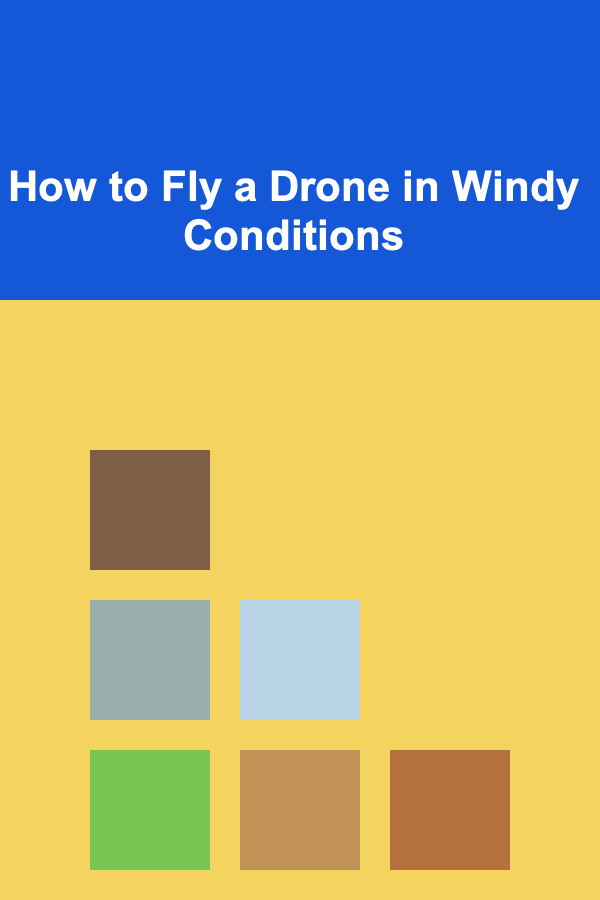
How to Fly a Drone in Windy Conditions
ebook include PDF & Audio bundle (Micro Guide)
$12.99$6.99
Limited Time Offer! Order within the next:

Flying a drone is an exciting and rewarding experience, offering aerial views that are difficult to capture by any other means. However, one of the challenges drone pilots often face is flying in windy conditions. Wind can significantly affect the stability, control, and safety of a drone, making it essential to understand how to navigate these conditions properly. Whether you are a beginner or an experienced pilot, knowing how to fly a drone safely and effectively in the wind is crucial to ensure both the drone's performance and your own safety.
This article will explore the complexities of flying drones in windy conditions, providing practical tips, techniques, and considerations to help you manage these challenges. By the end, you'll have a better understanding of how wind affects your drone and how you can optimize your flying experience in less-than-ideal weather.
Understanding How Wind Affects Drone Flight
Before delving into how to fly a drone in windy conditions, it's essential to understand the science behind how wind affects drone performance. Wind can have several impacts on your drone:
1.1 Stability Issues
Wind creates turbulence, which can cause your drone to sway, tilt, or become unstable. Strong gusts can make it difficult for the drone to maintain its position in the air. This can lead to erratic flight patterns and difficulty maintaining control, especially if the drone is a smaller model or lacks advanced stabilization technology.
1.2 Reduced Battery Life
Wind resistance can put additional strain on the drone's motors, causing them to work harder to maintain stability. This results in higher power consumption and shorter flight times. In windy conditions, your drone may deplete its battery faster than usual, so it's important to monitor the battery levels more closely.
1.3 Increased Risk of Accidents
Wind can make the drone harder to control, especially for beginners or if the wind is particularly strong. If you are flying in a location with unpredictable gusts or turbulent winds, there's a risk of losing control, causing the drone to crash or get damaged. It's important to be aware of the surrounding environment and avoid flying in wind conditions that exceed your drone's limits.
1.4 Impact on GPS and Communication Signals
In windy conditions, your drone may experience difficulty maintaining a stable GPS signal, which can affect its position-holding capabilities. Additionally, high winds can interfere with the communication between the drone and the remote control, especially if there are obstructions like trees or buildings. This makes it harder to control the drone at longer distances.
Assessing Wind Conditions: When Is It Safe to Fly?
Before you attempt to fly your drone in windy conditions, it's essential to assess the wind speed and determine whether it's safe to fly. Here are the key factors to consider:
2.1 Know Your Drone's Wind Limits
Different drones are built to handle various wind speeds, and it's essential to know the limits of your specific model. Most consumer drones are designed to fly in winds up to around 15-25 mph (24-40 km/h). However, flying in winds higher than this can cause the drone to struggle with stability and may increase the risk of crashes.
Check the drone's user manual or manufacturer's specifications for recommended wind conditions. Most manufacturers will provide the maximum wind speed that the drone can safely handle.
2.2 Wind Speed and Gusts
The steady wind speed is not the only factor to consider. Wind gusts can be more dangerous than sustained winds, as they are unpredictable and can cause sudden changes in your drone's altitude and position. For this reason, always check not only the wind speed but also any gust warnings in the area.
A general rule of thumb is that if the wind is gusting above 15-20 mph (24-32 km/h), it's probably best to avoid flying your drone unless you are an experienced pilot and your drone is designed to handle higher winds.
2.3 Local Terrain and Obstacles
The terrain and environment in which you are flying also affect how wind will impact your drone. Flying in an open field with minimal obstacles is typically safer than flying in an area with buildings, trees, or other structures that can create wind turbulence. Be mindful of how the wind may be channeled or amplified by these features.
Preparing for Windy Conditions
If you've assessed that it's safe to fly in windy conditions, preparation is key to ensuring a successful flight. Here are some tips on how to prepare:
3.1 Check Your Drone's Equipment
Before heading into windy conditions, perform a thorough inspection of your drone. Make sure that everything is functioning properly, including:
- Motors: Ensure the motors are in good condition and are free of debris that could interfere with performance.
- Propellers: Check the propellers for damage, as wind can exacerbate any existing cracks or chips. Ensure that they are tightly secured.
- Battery: Ensure the battery is fully charged and in good condition, as wind will demand more energy from the drone. Consider bringing an extra battery in case the first one drains faster than usual.
3.2 Utilize GPS and Return-to-Home Features
Many modern drones come equipped with GPS and Return-to-Home (RTH) features. These features are particularly useful when flying in windier conditions because they can help maintain the drone's position and return it to safety if control is lost.
Make sure that your drone's GPS system is functioning correctly before flying, and enable RTH as a safety feature. In windy conditions, it's also recommended to set the RTH altitude slightly higher than usual, as wind can push your drone into obstacles such as trees.
3.3 Set Your Drone's Settings
Most drones have adjustable settings that can help mitigate the effects of wind. Consider the following adjustments:
- Increase sensitivity: If you are an experienced pilot and comfortable in windy conditions, you can increase the responsiveness of the controls, allowing for quicker reactions to gusts.
- Stabilization settings: Enable any stabilization features on your drone, such as a gimbal lock or flight modes designed for windy conditions. These features can improve the drone's ability to hold its position in the air.
- Flight modes: Many drones have different flight modes, including sport, cinematic, and beginner modes. Choose a mode that offers greater stability and control, rather than opting for a sport mode that may make the drone more sensitive to wind.
Techniques for Flying in Windy Conditions
Now that you've prepared your drone, it's time to fly. Here are some essential techniques for flying in windy conditions:
4.1 Keep the Drone Close
When flying in windier conditions, it's crucial to keep your drone within your line of sight and as close as possible. This will give you better control and make it easier to react if the drone begins to drift.
- Avoid long-distance flights: If possible, fly the drone in an area where you can easily get to it if the wind pushes it off course.
- Fly in open areas: An open space free of obstacles like trees and buildings gives you more room to maneuver and better control over the drone's position.
4.2 Adjust Your Flying Speed
Flying too quickly in windy conditions can make it difficult to control the drone, especially if gusts hit unexpectedly. Keep your speed moderate and avoid sharp turns or aggressive maneuvers. Focus on making slow, controlled movements that allow the drone to adjust to the wind gradually.
4.3 Use the Wind to Your Advantage
If the wind is coming from a specific direction, use it to help you maintain position or to fly against it when necessary. For example:
- Flying into the wind: When flying against the wind, the drone will be moving slower relative to the ground, giving you more control. This also helps conserve battery power since the drone doesn't have to work as hard to counteract the wind.
- Flying with the wind: Flying with the wind can make the drone move faster, so be sure to slow down to avoid losing control. However, the wind will also help stabilize the drone, so you may find that the drone becomes easier to control in some cases.
4.4 Monitor Your Drone's Battery
Wind puts extra strain on the drone's motors and can cause a faster depletion of the battery. Keep a close eye on the battery level, and always plan for the return journey well before the battery gets too low. If you're flying in windy conditions, aim to return the drone to its starting point when the battery drops to about 30% or 40% to ensure there's enough power to navigate back safely.
4.5 Make Small Adjustments
When flying in windy conditions, make small, incremental adjustments to your drone's altitude, position, and orientation. Avoid making sudden movements, as the wind can amplify the effects of abrupt control changes. Use gentle and steady inputs to keep the drone balanced.
Safety Considerations
Safety is always the top priority when flying a drone, especially in windy conditions. Here are some safety tips to keep in mind:
5.1 Avoid Flying in Extreme Weather
If the wind is too strong or gusty, or if it's accompanied by rain or storms, it's best to avoid flying altogether. Flying in extreme weather conditions is dangerous for both the drone and the pilot, and the risk of accidents increases significantly.
5.2 Use Wind Alerts and Apps
Several mobile apps and weather tools provide real-time information about wind speeds and conditions. Use these resources to stay updated on the weather in your area and adjust your plans accordingly.
5.3 Know When to Abort
If the wind conditions become too challenging, or if you lose control of the drone, don't hesitate to abort the flight. Prioritize the safety of the drone and yourself over capturing footage or completing a task. Use the Return-to-Home feature to bring the drone back to safety, or take manual control if needed.
Conclusion
Flying a drone in windy conditions can be challenging, but with the right preparation, techniques, and safety precautions, it is entirely possible to navigate these obstacles successfully. By understanding how wind affects your drone, assessing wind conditions before flying, and using the proper techniques, you can safely fly your drone even when the wind picks up. Always remember to prioritize safety, keep your drone within your line of sight, and monitor battery levels closely to ensure a successful flight. With these tips, you'll be able to make the most of your drone, even in less-than-ideal weather.
Reading More From Our Other Websites

How to Organize a Potluck Dinner Party at Home
Read More
How To Understand Smart Hospitals and Integrated Care
Read More
How To Find Your First Remote Job: A Comprehensive Guide
Read More
How to Crochet Waterproof Crochet Bags
Read More
10 Tips for Perfect Leather Edge Finishing
Read More
How to Understand the Difference Between Term and Permanent Life Insurance
Read MoreOther Products

How to Organize a Potluck Dinner Party at Home
Read More
How To Understand Smart Hospitals and Integrated Care
Read More
How To Find Your First Remote Job: A Comprehensive Guide
Read More
How to Crochet Waterproof Crochet Bags
Read More
10 Tips for Perfect Leather Edge Finishing
Read More